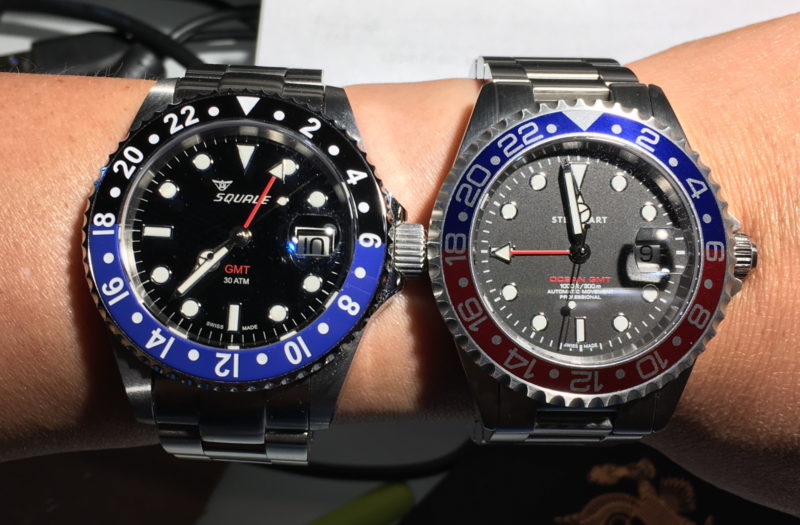Rolex Homages and Alternatives are two very distinct things. A Rolex homage is a cheap watch that looks like the original, but comes with cheaper components (Invicta 8926, Parnis, etc..)
On the other hand, a Rolex alternative has the same styling, but the specs & components are also damn-near identical to the original. In my opinion, the Steinhart Ocean One GMT and Squale 30 Atmos GMT are in the second category.
While they look very similar in surface, the Squale is a bit more expensive than the Steinhart, but is it worth the extra money? Let's find out!
Measurements
Steinhart GMT | Squale GMT | |
|---|---|---|
42mm | Case Diameter | 42mm |
50mm | Lug-to-Lug | 49mm |
13,5mm | Case Thickness | 13mm |
22mm | Lug Width | 21mm |
The first reason why I consider these two watches to be alternatives rather than homages is the case size. Indeed, the Ocean 1 GMT and 30 Atmos GMT both have a 42mm case, which is 5% bigger than the original GMT-Master II.
Although they share the same diameter, the Squale's L2L length is a millimeter shorter than Steinhart. This comes from the lugs which are slightly curvier, making the Squale a bit more comfortable on the wrist.

Another measurement that should have weight in your decision is the lug width. At 21mm, the 30 Atmos GMT's lug width is a bit unusual, which makes finding 3rd-party bracelets/straps a bit harder. Conversely, the Steinhart Ocean 1 GMT has a regular 22mm bracelet.
It's also good to note that both OEM bracelets taper down to 18mm at the clasp.
Specs
STEINHART GMT | SQUALE GMT | |
|---|---|---|
Flat sapphire | Crystal | Flat sapphire |
300m / 30 atm | Water Resistance | 300m / 30 atm |
Signed Screw-Down | Crown | Signed Screw-Down |
Ceramic Insert | Bezel | Ceramic Insert |
Superluminova BGW9 | Lume | Superluminova C1 |
Crystal
In accordance with the Rolex Submariner tradition, the Steinhart and Squale GMT both use a flat sapphire crystal with a cyclops lens over the date display.
The first dissimilarity between the two crystals is the date magnifier. On the Squale 30 Atmos, you get a 2.5x magnifying glass, just like the one on the Rolex Submariner. On the other hand, the Steinhart GMT only uses a 1.5x magnifying lens, which is a bit disappointing.

Another distinction between the crystal of the two watches is the anti-reflective coating. While both crystals are applied with AR-Coating on the inside of the glass, Steinhart claims to have 2 layers of coating, instead of 1 like on the Squale.
In reality, I think this double layer is more of a gimmick than a real benefit, especially considering the fact that flat crystals aren't inherently reflective.
Water Resistance & Crown
While most basic homage watchmakers are content with 200m of water resistance like the old Submariner used to have, Steinhart and Squale bump this figure up to 300m like the real deal.
Of course, the two watches are equipped with a screw-down crown to avoid accidentally pulling it out in a diving situation. Also, both watchmakers sign the crown with their respective logos.

I must say that the Steinhart and Squale GMT have awesome crowns that are buttery-smooth to operate, so it's really a tie in this aspect of the watch.
However, it's important to note that the Squale's crown is very big (could be called a Jumbo Crown), so the styling is not for everybody. Also, it might dig into your wrist if you wear your piece close to your hand.
Bezel
I think the bezel is important both for aesthetical and functional purposes, especially for a GMT watch. The Steinhart Ocean 1 GMT and Squale 30 Atmos GMT are equipped with a 120-click unidirectional bezel.
Although the two watches have a stainless steel bezel with a ceramic insert, they are quite different in practice. For instance, the Steinhart's insert has a bright glossy finish that's a bit too reflective for some people.

On the other hand, the 30 Atmos GMT's bezel insert has more of a matte finish, and the numerals are etched, which is a sign of great quality. However, Squale catches a lot of flack for inverting the colors on their Pepsi bezel (red on top, blue down).
In contrast, the Steinhart's shiny insert gets its lot of criticism, but no one can argue how great the bezel feels. Indeed, the edge makes for a super easy to grip & turn bezel, which isn't the case for the Squale 30 Atmos.
Lume
If you want to compete with the Rolex GMT-Master II on any level, you have to use great lume. Knowing that, Steinhart and Squale both use a Superluminova formula, which is notoriously the best lume-maker on the market.
However, the two watchmakers chose a different approach. Steinhart decided to use the BGW9 application, which is the second brightest in Superluminova's lineup. Not only is it bright and durable, but it also has a nice white color during daytime.

On the other hand, Squale uses the C1 application for the 30 Atmos GMT model. In theory, this lume is much duller than the BGW9 formula, but Squale applied more of it. The final result is a pretty similar lume in terms of brightness and longevity.
It's also good to note that the Steinhart's lume is blue versus the green lume on the Squale.
Movement
STEINHART GMT | SQUALE GMT | |
|---|---|---|
ETA 2893-2 | Caliber | ETA 2893-2 |
Automatic | Type | Automatic |
28,800 bph | Frequency | 28,800 bph |
42 hours | Power Reserve | 42 hours |
+- 7 sec/day | Accuracy | +- 7 sec/day |
Hacking, Hand-Winding, ETACHRON, GMT | Special Features | Hacking, Hand-Winding, ETACHRON, GMT |
If you're looking for an affordable Swiss GMT movement, there are not many options on the market. This explains why Steinhart and Squale use the same ETA 2893-2 caliber for their GMT watches.
Fortunately, the ETA 2893-2 is an excellent movement with a long history of reliability and accuracy. Indeed, the two watchmakers use the "Élaboré" rated version of this caliber, which keeps time within +- 7 seconds/day on average, with no more than 20 sec/day variation.

In practice, some Steinhart and Squale owners mention that their watches keep time even more accurately, often in the 3-5 sec/day range. Thanks to the ETACHRON regulator, you can keep your 2893-2 very accurate without much horology knowledge.
Like most high-end Swiss movements, you get hacking, hand-winding, and a smooth second hand sweep from the 28,800 bph frequency.
Unfortunately, this high frequency matched with the power draw of the GMT hand brings down the power reserve to a measly 42 hours. This isn't that bad of a reserve, but it's certainly a downgrade from the usual 50 hours reserve of other ETA movements.
Design
STEINHART GMT | SQUALE GMT | |
|---|---|---|
GMT Master-II Homage | Styling | GMT Master-II Homage |
Glossy | Dial | Glossy |
Mercedes | Hands | Swords |
Submariner | Indices | Submariner |
316l Stainless Steel | Case & Bracelet | 316l Stainless Steel |
Dial
The Steinhart Ocean 1 GMT and Squale 30 Atmos GMT share the same glossy dial that's found on the original GMT Master-II. The two main differences between their respective dial are the logo and scripts.
First, Steinhart does apply its logo at the top of the dial, but it's quite small and non-obtrusive. On the other hand, Squale's logo is also painted at the top of the dial, but this one is bigger and louder (larger font, takes more real estate).


Secondly, Steinhart tries to replicate as much as possible the GMT-Master II's dial with the four lines of text below the center of the dial. Conversely, Squale's script is only 2 lines, and they're much shorter.
The rest of the dial is pretty much indistinguishable, including the "Swiss Made" script that both brands proudly display at the 6 o'clock position.
Hands & Indices
Of course, none of these watchmakers are bold enough to omit the Submariner indices for a GMT-Master II homage. However, Squale decided to steer clear from the Mercedes hands for their MK2 version of the 30 Atmos GMT.
Indeed, Squale uses straightforward sword indices with a large area for lume application on this new model. If you absolutely want a set of Mercedes hands for your GMT-Master II homage, you can get the MK1 (40mm) version of the 30 Atmos.
Conversely, the Steinhart stays true to the original and keeps using a classic set of Mercedes hands.

For the GMT hand, both watchmakers use the same simple arrow design as the GMT-Master II. However, a lot of people dislike the shortness of the Squale's GMT hand. It's as if the hand was pointing towards the chapter ring rather than the bezel's 24-hour layout.
This might not be so apparent in pictures, but it's definitely something you will notice if you have both watches next to each other.
Case
The two watch cases are made of 316l stainless steel and feature brushed lugs and polished sides. As I mentioned above, the Squale has slightly curvier lugs wich makes the 30 Atmos wear a bit smaller and more comfortable than the Ocean 1 GMT.
Additionally, Squale has a very good reputation as a case maker. Indeed, they used to make cases for reputable brands such as Blancpain, Tag Heuer, and many more. For this reason, I must admit that the 30 Atmos GMT's case is a notch above Steinhart in terms of quality.
Bracelet
Any true diver will tell you how important a good bracelet is on a dive watch. Fortunately, both Steinhart and Squale make amazing bracelets that are comfortable and durable.
The two bracelets have features you would expect from high-end watches such as solid end-links, machined clasp, etc..

However, the Squale 30 Atmos GMT is the only one that has a diver extension, so it's definitely the best option if you plan on diving with your piece.
On the other hand, the Steinhart doesn't have an extension, but it does have 2-piece end links, which help the Ocean 1 GMT wrap around your wrist perfectly.
Value
STEINHART GMT | SQUALE GMT | |
|---|---|---|
€540.00 ($610) | Pricing | $750 |
2-year | Warranty | 2-year |
Medium | Brand Recognition | Medium |
Pricing
At $600-$650 (depending on exchange rate), the Steinhart Ocean 1 GMT is undoubtedly the best bang-for-the-buck watch of the two. However, it lacks certain features that you might deem absolutely necessary such as a diving extension on the bracelet.
On the other hand, the Squale 30 Atmos GMT is a bit more expensive, but it does have a slight edge over Steinhart when it comes to the general quality and wearability of the watch.
All in all, I think those two watches are very reasonably priced and you shouldn't base your decision on this criterion alone.
Warranty
Both Steinhart and Squale offer a worldwide 2-year warranty against fabrication defects. Also, the two warranties are transferable to the new owner in case you want to sell it or buy a pre-owned example.
Brand Recognition
Steinhart and Squale are two brands that are well-respected within the watch community, but won't ring a bell to the average population.
I must admit that Squale's brand reputation is a bit higher than Steinhart. As I mentioned above, Squale used to sell cases to reputable European brands, so their name is often associated with quality.
On the other hand, Steinhart is often associated with homages and this tarnishes the brand's name a little bit. However, I do not think it's fair to qualify Steinhart as an homage brand since they now sell a bunch of original concepts.
Get The Ocean 1 GMT if you: | get the 30 atmos gmt if you: |
|---|---|




